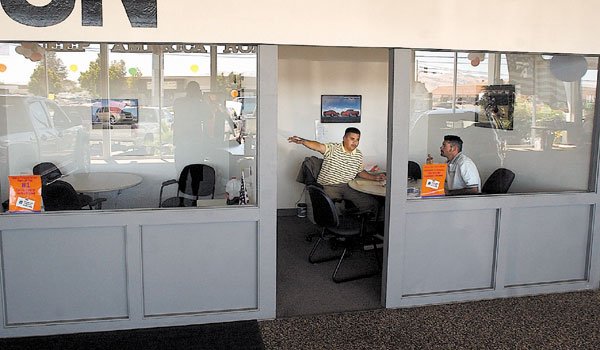So, the old family clunker finally clunked out for the last time
and you’re SOOW: so out of wheels.
So, the old family clunker finally clunked out for the last time and you’re SOOW: so out of wheels. Before you cut the check for a down payment on the car of your dreams, take a little time to research, a little time to think and a little time to collect yourself.
Whether buying new or used, some of the same rules apply. First among them, be realistic and rational, according to AAA of Northern California Spokeswoman Cynthia Harris.
“Take an honest look at your financial situation and keep within your price range,” said Harris. “It becomes an emotional issue when you buy a car, but when you go into the dealership, it really has to be a business decision and a business judgment.”
Consider the cost of car payments, insurance and repairs, said Harris, and don’t forget to factor in hidden costs like delivery fees, options charges and warranty limitations.
“Hidden costs can easily add up to 10 percent or more,” said Harris. “The dealership can have a fee for options like power windows or door locks, sun roof, leather package or other things in the car you like. Make sure you really look at the contract before you sign anything.”
It’s also important to stay focused when picking a car. It’s easy to love an engine’s muscle or the sleek lines of a sports car, but rank the things you’re really after before you go shopping, said Harris.
“You want to decide what’s most important to you,” she said. “Rank things like safety, fuel economy, reliability, style and performance as well as the car’s cost to buy and cost to drive. This gives you an idea of what you’ll be willing to sacrifice if you need to cut something.”
Someone looking for a lifestyle-based vehicle may be willing to live with the poor fuel economy of an SUV while a commuter might want to find something with excellent fuel economy and a smooth ride that’s easy to park. For owners who plan to resell their vehicles, the vehicle-buying process is also a chance to look long-term. Picking a popular four-door model in a marketable color may pay off in the long-run, said Harris.
Don’t worry too much about mechanical problems with a new vehicle, though, said Ron Engebretson, owner of Monterey Auto Service in Morgan Hill.
“What I would do is try to get some kind of consumer report on how the vehicle rates,” said Engebretson. “See what other people have to say about the car and be as educated as possible.”
When buying used, it’s best to be a bit more thorough, said Engebretson.
“Look under the hood and make sure there are no fluids leaking,” said Engebretson. “Drive it and make sure there are no abnormal noises or vibrations. Look at the body panels to see if you find anything like overspray or painting.”
Beyond that, Engebretson suggested checking out all of the car’s features, from making sure the air conditioner actually blows cold air to ensuring the power steering works.
After that, take the car for a check-up with your local mechanic, Engebretson advised.
For a fee of about $75, a mechanic should be able to check the car more thoroughly for leaks, worn brakes and soon-to-go parts, said Raul Romero, mechanic and owner of Rom’s Auto Service in Gilroy.
“Most people worry about the engine, but the safety of the car is most important,” said Romero. “A lot of times, a little check can save you lots of time and money. I give customers an estimate of whatever the car needs, and they can take it back to the seller to talk over the price and repairs, or they can find another car.”
To inspect for previous accidents or poor repairs, it’s also advisable to have a used car looked over by a qualified auto collision technician, according to Loretta Volpi, owner of Rocci’s Auto Collision Inc. in Morgan Hill.
“We have seen a lot of grossly negligent repairs come in here that we wouldn’t even touch due to the fact that they were repaired so badly,” said Volpi. “There are tell-tale signs to look for, even if it was a good repair, and safety is the main concern.”
Prospective car buyers should be sure to do their homework and shop around before pulling out a checkbook, though, said Harris.
“Go to consumer magazines,” said Harris. “Learn as much about that particular vehicle as possible and compare prices. Then, when you go to a dealership or a seller, and they’re charging 15 percent more than the car regularly goes for, you’ll know. That’s the point where you really have to be in charge of the decision process.”
The more a consumer knows, said Harris, the less likely he or she is to be suckered into purchasing a car they don’t want or can’t afford – an especially important bit of knowledge since most cars are major investments.
Now about that red Corvette ….












